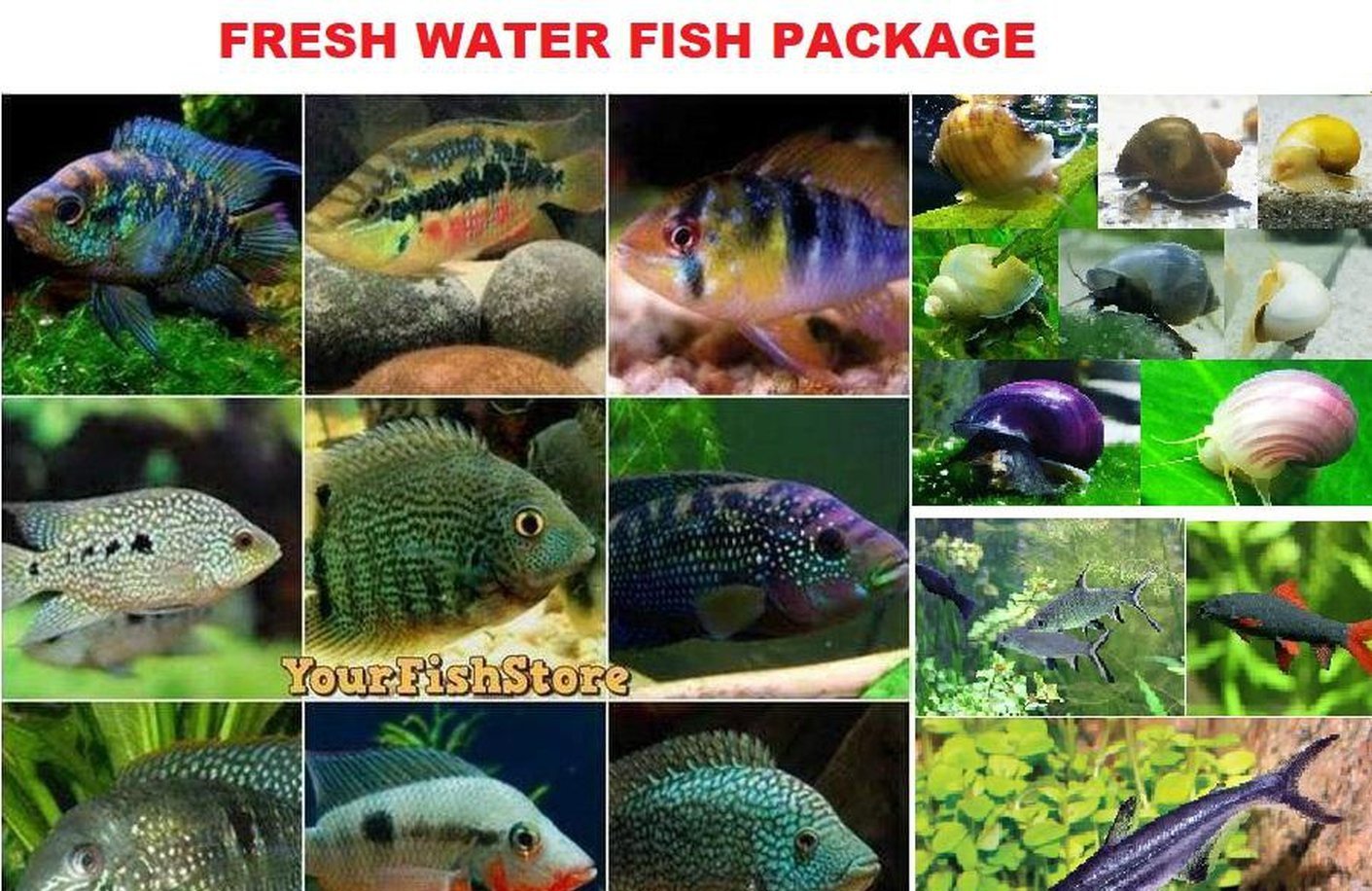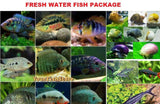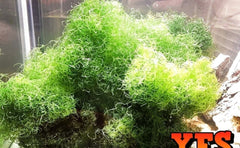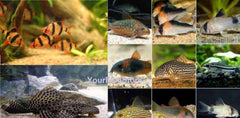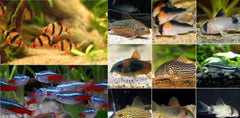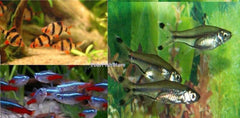x10 SOUTH AMERICAN CICHLIDS (1-2") / x10 MYSTERY SNAILS / x5 PLECOS / x2 SHARKS / x2 BETTA FISH (FREE)
Ebay
$ 143.53

FRESH WATER FISH PACKAGE - EASY CARE LEVEL
-------------------------------------------------------------
This Package Contains:
x10 Assorted South American Cichlids Sm/md (Approx 1"-2" Each)
x10 Mystery Snails
x5 Florida Plecos Sm/md (Approx 1"-2" Each)
x2 Assorted Sharks Sm/md (Approx 1"-2" Each)
x2 Betta Fish (FREE)
-------------------------------------------------------------
Cichlid Care:
Minimum Tank Size: 55 gallons
Care Level: Easy
Temperament: Moderate
They will be scooped out our holding tanks. We cannot guarantee we will be able to scoop ALL different types, but we will try to get a good variety.
South American cichlids are attractive, active, are generally quite durable fish. They are found in a range of sizes and with some very beautiful coloration.
Their behaviors are very intriguing, and many interact with their keepers and their environment making them favorite aquarium fish for many hobbyists.
Cichlids are found around the globe, in the Americas, Africa and parts of Asia. The “type specimen” for the cichlid family is the South American cichlid Cichla ocellaris, commonly known as the Peacock Bass or Peacock Cichlid. Thus the American cichlids are sometimes referred to as the “true cichlids” though all species are actually true cichlids.
The South American Cichlids or New World Cichlids are those found primarily in Central and South America, with a number of species native to Mexico, and the Texas Cichlid found in the southern part of North America. The actual number of cichlid species is unknown but estimated at more than 2000, with at least 1300 species scientifically described. South American Cichlids and Central American Cichlids are estimated at about 570 species.
They are categorized as "secondary freshwater fish" - meaning their ancestors were marine fish. It is believed that cichlids moved to freshwaters from the marine environment, and they have features relating to a number of marine species including the damsels, wrasses, parrot fish, and surfperches. This helps to explain why many species can do well in salty water, and in fact some species extend their range into parts of the ocean.
Possible Random Selection that may be included when we scoop them out of holding tub:
Jack Dempsey Cichlid
Blue Acara Cichlid
Keyhole Cichlid
Green Severum Cichlid
German Blue Ram Cichlid
Peacock Bass Cichlid
Dovii Cichlid
Green Terror Cichlid
Apistogramma Pucallpaensis Cichlid
Thorichthys Ellioti Cichlid
Blue Kribensis Cichlid
Golden Dwarf Acara Cichlid
Vieja Argentea Cichlid
Chocolate Cichlid
Zebra Pike Cichlid
Neetroplus Nematopus Cichlid
Geophagus Altifrons Cichlid
Jewel Cichlid
Gold Severum Cichlid
Acarichthys Heckelii Cichlid
Texas Cichlid
Kribensis Cichlid
Pink Convict Cichlid
Geophagus Jurupari Cichlid
Sajica Cichlid
Krobia Itanyi Cichlid
Rainbow Cichlid
Firemouth Meeki Cichlid
Checkerboard Cichlid
Aequidens Diadema Cichlid
Longfin Gold Ram Cichlid
Paratilapia Bleekeri Cichlid
Vieja Argentea Cichlid
Bolivian Ram Cichlid
Electric Blue Ram Cichlid
Geophagus Brasiliensis Cichlid
Fire Red Apisto. Agassizi Cichlid
Herichthys Bocourti Cichlid
Black Convict Cichlid
Blonde Honduran Red Point Convict Cichlid
Albino Kyoga Red Xystichromis sp. Cichlid
Apistogramma Erythrura Cichlid
Balloon Blue Ram Cichlid
Balloon Electric Blue Ram Cichlid
Bandit Cichlid
Double Red Apisto Cacatouides Cichlid
Electric Blue Acara
Geophagus sp. Rio Negro Cichlid
-------------------------------------------------------------
Pleco Care:
Plecostomus Water Requirements
Loricariid catfish are typically found in soft water with a low pH in the wild, however, many species sold today are commercially raised and tolerate a much wider range of water chemistry. A pH between 7.0 and 8.0, alkalinity between 3° and 10° dKH (54 ppm to 180 ppm) and temperature between 74° and 80° F will suffice for most captive bred species. If the aquarium is kept in a room below 74°, use an Aqueon Aquarium Heater to maintain the proper temperature. Wild caught fish may require a temperature in the mid to upper 80’s, pH of 5.5 to 7.0, and alkalinity below 3° dKH (54 ppm), so it is best to research fish you are unfamiliar with before purchasing. Maintain good filtration and do a 10% water exchange every week or 25% every 2 weeks using an Aqueon Aquarium Water Changer or Siphon Vacuum Gravel Cleaner. Do not forget to treat tap water with Aqueon Water Conditioner before refilling your aquarium!
Housing Requirements for Plecostomus
With so many species of suckermouth catfish to choose from, no matter what size aquarium or type of fish you own, there is one just right for you. For example, the common pleco, Hypostomus plecostomus, can grow to over 12” and will eventually need an aquarium of at least 75 gallons, while Otocinclus will be perfectly content in a 10-gallon tank. Plecostomus tend to be secretive, so caves, hollow logs and other size-appropriate hiding places should be available in the aquarium. Moderate to good circulation should be provided to simulate the fast-moving rivers many species inhabit in the wild. Decorate the tank with driftwood for refuge as well as a source of food.
Plecostomus Behavior/Compatibility
Many suckermouth catfish are nocturnal and spend a good portion of the day hiding in a crevice or under an overhang. However, some will adapt to aquarium life and be more sociable during the day, especially at feeding time. Loricariids are compatible with most aquarium fish, although tank mates should be roughly the same size as they are. Large predatory fish may try to eat smaller pleco’s or Otocinclus, resulting in the catfish becoming lodged in the bigger fish’s throat. On the other hand, large plecos can be safely mixed with smaller fish as they will not usually try to eat them.
What Do Plecostomus Eat?
While plecostomus and other suckermouth catfish are typically sold as algae eaters, some species are carnivorous, feeding on carrion in the wild. Others feed almost exclusively on wood, so it is best to research the dietary needs of any species you buy. Aqueon Bottom Feeder Tablets, Shrimp Pellets, Tropical Granules and Algae Rounds can all be excellent foods for these catfish. Because of their nocturnal habits, many experienced hobbyists target feed their plecos once or twice a week with tablet or disc foods given at night. For best results, feed a variety of high-quality foods and rotate your fishes’ diet daily.
-------------------------------------------------------------
Customer Reviews
No reviews yet
Write a review
QUESTIONS & ANSWERS
Have a Question?
Be the first to ask a question about this.

